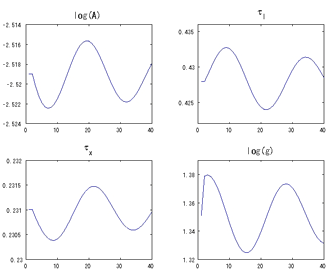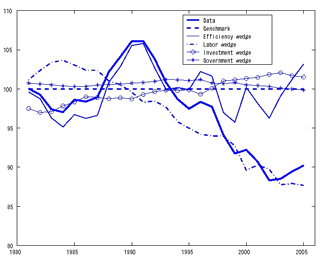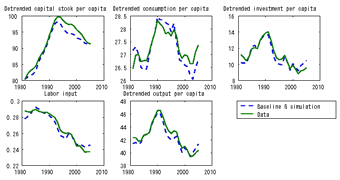While the economy continues on its lengthy road of recovery, the problem of inequality is growing worse in Japan. How should we interpret this situation? And how will it affect Japan's efforts to restore its fiscal health?
This column (September 6, 2005) previously reported findings from a simple analysis of economic fluctuations in Japan from the 1990s through the early 2000s using a method called business cycle accounting (BCA). That column could not provide detailed analysis of the recovery phase from 2002 onward due partly to a lack of pertinent data. Subsequently, a substantial amount of data were collected and the analytical method was somewhat improved. In light of these developments, we will examine the issues raised at the outset of this article by once again using the BCA method. Our discussion here is based on and evolved from "Business Cycle Accounting for the Japanese Economy Using the Parameterized Expectations Algorithm," RIETI Discussion Paper (07-E-061). Readers can refer to this paper for further details of our analytical findings.
Analysis of the Japanese economy using the BCA method
BCA is an analytical method developed and advocated since around 2002 by Varadarajan V. Chari, Patrick J. Kehoe, and Ellen R. McGrattan of the University of Minnesota. (The validity and robustness of this method continue to be disputed between Chari et al. and L. Christiano et al. at Northwestern University.) For three years we have been using the BCA method to analyze the Japanese economy.
As a model that describes the real economy, BCA is based on thinking similar to the model advocated by Edward C. Prescott, which tries to adopt the simplest possible optimization problem and can be defined as a generalized form of growth accounting. First, it is assumed that the real economy can be described by a neo-classical growth model that is inhabited by a representative agent. Then, it is assumed that changes in output, consumption, investment, and labor at the macroeconomic level can be explained by four exogenous shocks: changes in productivity (efficiency wedge), changes in a hypothetical tax on labor income (labor wedge), changes in a hypothetical tax on investment expenditures (investment wedge), and changes in government spending (government wedge). The hypothetical taxes represent distortions (wedges) in the labor and investment markets in the form of "taxes."
Based on these assumptions, values for the four wedges are estimated so as to reproduce the actual data. Then, using these estimated values, a simulation is performed to examine to what extent each wedge can explain business cycles. The earlier column (Kobayashi 2005) reported on findings from an analysis of factors behind Japan's prolonged recession using the BCA method, showing that in addition to changes in productivity, the deterioration of the labor wedge was a major factor.
This time around, we have expanded the scope of our analysis, extending the data to cover the years through 2005 and assumed that the wedges fluctuate in accordance with a certain stochastic process (see RIETI Discussion Paper 07-E-061 for details on this method). The results are shown in Figure 1 below. In the figure the benchmark, plotted as a horizontal, bold dashed line at 100, represents the level of hypothetical output (GNP) based on the assumption that the four wedges are fixed at their respective average values for the period 1984-1989. The effect of each wedge is shown as deviations from the benchmark. For instance, where the thin solid line representing the efficiency wedge is above the benchmark, the efficiency wedge is seen to have an expansionary effect on the economy. The bold solid line represents Japan's actual gross national product (GNP), showing the deviation from the benchmark.
Why are the gaps widening amid the economic recovery?
Because this time we have included additional data covering the period 2002-2005 in our analysis, we can analyze factors behind the economic expansion from February 2002 to the present. Based on the results shown in Figure 1, we can conclude that the recovery of productivity is essentially the only main factor behind the ongoing economic recovery. The thin solid line (efficiency wedge) shows a remarkable upward trend since 2002, which has resulted in the recovery of the bold solid line (actual GNP). The labor wedge has also continued to deteriorate throughout that recovery period. The dot-dashed line (labor wedge) in Figure 1 shows no sign of recovery.
The current inequality problem in Japan that is getting serious despite the economic recovery may be related to the continuing deterioration of the labor wedge. It remains unclear what changes in the real economy have resulted have caused this. The previous column (Kobayashi 2005) pointed to the possibility the labor wedge might have been aggravated by financial problems such as collateral constraints. In the period 2002-2005, Japan was still anxious over the financial system's soundness and the proportion of non-regular employees was on the rise. Although the problem of nonperforming loans is over for major banks, the situation remains difficult for regional financial institutions. All these problems with the financial system may be continuing to negatively impact the labor market. If distortions in labor demand, which are causing the inequality problem, are attributable to these problems, it may be necessary to restore the health of regional financial institutions.
However the causes of the labor wedge deterioration are not necessarily clear. It needs to be noted the labor wedge has been deteriorating as a general trend over the past half century; it has trended this way since 1960 (the cause is unclear but the increased rigidity of the labor market, typified by the development of long-term employment in the postwar period may be responsible).
Whatever the reason, the labor wedge continues to deteriorate amid the continuing economic recovery. This indicates the presence of some sort of inefficiency in the labor market. The problem of inequality - particularly the problem of non-regular workers and the working poor - is seen as one symptom brought on by the inefficiency of the labor market. It certainly appears that labor market reform will be a major policy issue.
Fiscal policy and prolonged recession
Amid the ongoing economic recovery, fiscal reconstruction is becoming a major topic of discussion in parallel with the problem of inequality. From here we will briefly examine how the fiscal problem looks from the viewpoint of BCA. In order to look at the impact of fiscal policy, we simulated a case in which the level of government spending remains unchanged during the recession period. It was assumed that three of the four wedges - excepting the government wedge (government spending) - perform as estimated, while the government wedge remains unchanged from 1980 through 2005 at a fixed level, specifically, the average of the estimates in 1984-1989. The results are shown in Figure 2 below.
The case is designed to simulate what would have been the case had the Japanese government kept its fiscal policy unchanged from that in 1980s, throughout the bubble economy period and the subsequent prolonged recession. Simulation results show that output, investment, and labor input decreased through the 1990s but consumption increased. In the neoclassical business cycle model, the combination of increased consumption and decreased labor (or, increased leisure time) means an increase in social welfare. Thus, if we take these simulation results at face value, Japan's social welfare might have been better off if the government had not pursued expansionary fiscal policy in the 1990s. This naturally contradicts many people's intuition. First, a decrease in labor input is normally seen as an outcome of involuntary joblessness or job reshuffling, rather than an increase in leisure time. And if such is the case, the decreased labor input should have been an indication of deteriorating social welfare. Also, the increase in consumption observed in the simulation is attributable to the assumption that government spending is government consumption (a waste of resources with no benefit to consumers). This interpretation is because the simulated level of government consumption was lower than the actual level; simulated private consumption was boosted by an amount equal to the gap in government consumption. In that, the Keynesian multiplier effect, wherein government spending boosts consumer spending, is entirely ignored.
If the Keynesian multiplier effect is taken into account, how can it be captured? Under the analysis framework using the BCA approach, the effect may be observed as a phenomenon in which government spending affects other wedges, leading to an increase in consumption. Inaba (2007) assumes that the four wedges - including the government wedge - fluctuate and interact under the stochastic process AR(1) and then estimates parameters governing that process. The results are shown in Figure 3.

Figure 3: Impulse responses from one standard deviation shock to government spending
Click to enlarge
Figure 3 shows how the four wedges fluctuate when government spending increases at a time point (t=1) due to an exogenous shock. In response to the shock, the four wedges oscillate and eventually return to their respective steady states. Initially, the labor wedge increases while productivity (log A) goes down. That is, the labor wedge deviates toward increasing distortions in economic activity. (As far as GNP is concerned, BCA findings show that increasing government spending results in increasing GNP. This does not contradict the deterioration of wedges in the economy. That is, when government spending increases, government consumption increases and reduces the resources available for private consumption. This prompts people to work more in order to increase consumption, resulting in an increase in output. This mechanism, however, does not contradict the observed result that an increase in government spending leads to an increase in distortions in the economy.)
The results shown in Figure 3, if the BCA-generated estimates are to be believed, also lead to the conclusion that a fiscal expansion is not good for the economy. There might be some problems with our assumptions or methodologies employed for estimation of the stochastic process, thus with a good deal of reservation, we conclude that the Keynesian effect (fiscal expansion boosts private consumption) could not be derived by calculation for BCA.
Implications for the future
These BCA findings allow us to say that a sign for the recovery of the labor wedge is absent today despite our being in the midst of economic recovery. The labor wedge deterioration may be attributable to the institutional ineffectiveness of the labor market or it may be associated with local financial institutions' risk-averse attitudes toward lending. Those problems are no doubt related to the ongoing problem of inequality. We believe the government needs to step up efforts to reform the labor market and implement measures for the revitalization of local financial institutions and local economies.
As to fiscal policy, which depends considerably on the assumptions of the analysis, we cannot take the findings at face value. However, at least based on our analysis of the stochastic process of the wedges, an increase in government spending conceivably has no positive effect on other wedges. Should it be the case, it might not cause much problem even if the government proceeds with an austerity budget to restore the fiscal health. In any event, it is necessary to comprehensively research public finance and fiscal policy by applying other analytical methods.





